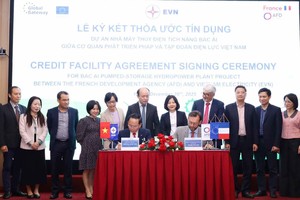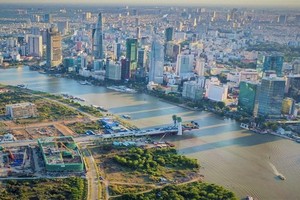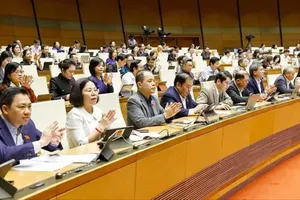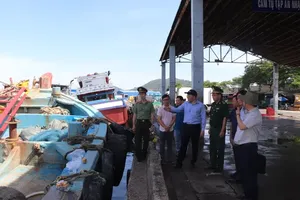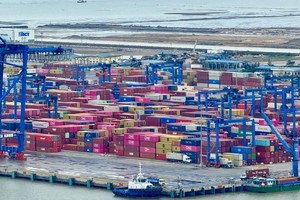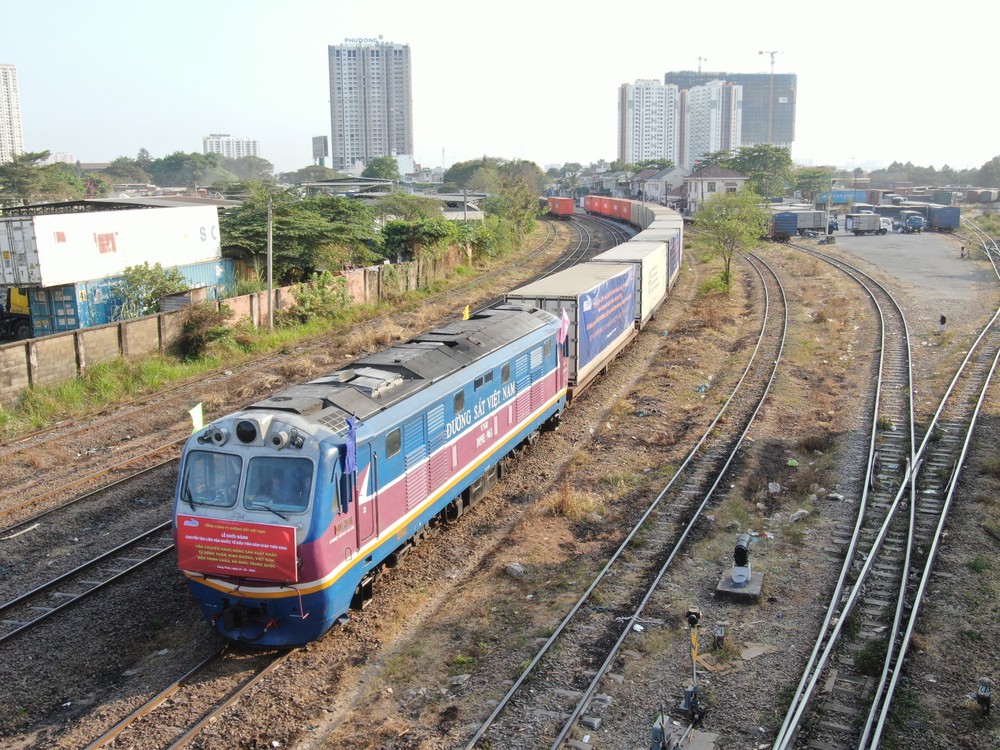
After several years of restructuring the transportation market, the railway sector still holds less than 1 percent market share, while maritime and waterway transportation accounts for less than 20 percent, with road transport remaining the predominant mode. Consequently, at the end of March 2024, the Ministry of Transport convened a meeting to discuss solutions to address this issue. However, the prevailing reality indicates that numerous challenges persist.
Ineffective solutions despite numerous attempts
The Vietnam Railway Corporation (VNR) has recently declared a significant upturn in revenue within the railway sector, marking a notable shift from years of financial losses. The company has achieved a post-tax profit of VND4.5 billion, a sharp increase compared to the VND173 billion loss recorded in 2022.
Noteworthy performances were observed among its subsidiaries, with the Saigon Railway Transport Joint Stock Company reporting a profit of VND10.7 billion and the Hanoi Railway Transport Joint Stock Company posting a profit exceeding VND14 billion.
Contributing to this growth is passenger transportation. In 2023, the railway sector transported 6.1 million passengers, marking an increase of 135.4 percent compared to the same period in 2022. This is the result of self-renewal efforts, with many new services being launched for the first time. Of these, the introduction of high-quality train services on the Hanoi - Da Nang route since October 2023 is the most remarkable.
Mr. Do Van Hoan, Chairman of the Board of Directors of Hanoi Railway Transport Joint Stock Company, stated that the company had invested nearly VND5 billion in upgrading carriages, a relatively modest amount but resulting in almost a 50 percent increase in train revenue. Currently, trains have an occupancy rate of approximately 80 percent.
Building on this success, the railway sector has recently introduced high-quality train services on the Hue - Da Nang route, achieving a high occupancy rate of over 90 percent. Additionally, the railway sector has been collaborating with localities and tourism entities to offer various products such as the Hanoi - Hai Phong food tour train and travel combos to destinations like Quang Binh, Nha Trang, and Hue.
Recently, the Vietnam Railway Corporation has also begun offering charter train services, tailoring journeys and services entirely to the preferences of the chartering party. However, the revenue generated from passenger transportation in the railway sector remains significantly lower compared to road and air transport.
While passenger transportation shows positive signs, freight transportation by rail is on a downward trend. The railway sector has actively opened new international intermodal routes and initiated international intermodal operations at inland terminals, such as Kep Station in Bac Giang Province, Yen Vien Station in Hanoi, and Song Than Station in Binh Duong Province.
However, in 2023, freight transportation merely reached 4.6 million tons, accounting for 0.3 percent of the total transportation market share. Mr. Dang Sy Manh, Chairman of the Board of Directors and General Director of Vietnam Railway Corporation, acknowledged that both the volume and revenue of railway transportation did not meet expectations and declined compared to the same period in 2022.
In maritime and inland waterway transportation, there was a 15.5 percent growth in 2023 compared to 2022. Specifically, inland waterway freight transportation reached 476 million tons (up 18.7 percent), while maritime freight transportation amounted to 116 million tons (up 7.8 percent). Passenger transportation via inland waterways rose by 6.4 percent, and by sea, it climbed by 10.2 percent.
In the first months of 2024, maritime and inland waterway transportation continued to maintain growth momentum. However, according to Minister of Transport Nguyen Van Thang, the market share remains significantly below its potential, prompting the need to accelerate this rate to 50 percent.
Improving infrastructure, service quality
According to economic expert Nguyen Dinh Anh, the recent positive trends in railway passenger transportation indicate a high demand for rail travel among the public. Especially, amid the challenging situation faced by the aviation industry, marked by aircraft shortages and soaring input costs, resulting in steep airfares, the railway sector has an excellent opportunity to reclaim market share.
However, achieving this requires addressing inherent weaknesses, such as train travel times, service quality, noise, and vibrations. In terms of freight transportation, the railway sector encounters difficulties related to infrastructure, terminals, logistics services, and insufficient integration with other modes of transport, particularly maritime ports.
Mr. Dang Sy Manh points out that rectifying these shortcomings poses a significant challenge due to the antiquated and inadequate railway infrastructure. Between 2016 and 2020, four projects aimed at upgrading critical facilities along the Hanoi - Ho Chi Minh City railway line were undertaken, with an investment totaling around VND7 trillion.
For the period from 2021 to 2025, eight projects are underway, with a budget of VND9.58 trillion. While these endeavors have improved infrastructure quality, they have yet to yield a transformative impact on the sector. Mr. Dang Sy Manh emphasized that unlocking the railway's potential and expanding its market share in transportation requires a breakthrough in railway investment. However, the sluggish progress in investing in new railway projects as per the plan suggests that the railway transportation market share expansion remains a story for the future.
If the challenge of increasing the market share of railway transportation lies in infrastructure, then boosting the market share of maritime and inland waterway transportation faces hurdles in terms of mechanisms and policies. Mr. Tran Do Liem, Chairman of the Vietnam Inland Waterway Transport Association, highlights that professionally managed waterway vehicles have yet to capture a significant market share and operate inconsistently. Moreover, the government does not prioritize credit support for enterprises in this sector.
Currently, the investment threshold of VND3 trillion to qualify for incentives is deemed excessively high. In reality, investments in inland waterway ports capable of accommodating vessels up to 20,000 tons merely range from VND300 billion to VND400 billion at most. Liem suggested that the Ministry of Transport promptly revise the standards for river vessels, providing comprehensive regulations for shipbuilders and residents alike to avoid wasting time and reduce investment costs for vehicle development.
Due to challenges with local vessels, Vietnam's maritime transport heavily relies on foreign shipping companies. This dependence has resulted in many difficulties and increased costs for domestic manufacturing and import-export businesses. Mr. Nguyen Hoang Anh, Secretary of the Vietnam Ship Agents, Brokers, and Maritime Services Providers Association, notes that foreign shipping lines currently impose approximately ten types of additional fees for cargo handling at ports.
These companies unilaterally and continuously raise surcharges. Representatives from the Vietnam Maritime Administration are actively collaborating with shipping lines to amend existing regulations, aiming to restrict arbitrary price increases.
Regarding fundamental solutions, Mr. Tran Bao Ngoc, Director of the Transport Department under the Ministry of Transport, underscored the urgency of accelerating infrastructure investment in the railway sector. The maritime industry should prioritize reviewing and proposing amendments to the 2015 Maritime Law, submitting competent authorities to approve planning and execute planning effectively, implementing the planning to enhance the maritime fleet, and ensuring the timely progress of dredging and channel maintenance initiatives.
Regarding inland waterway transportation, it is essential to refine the legal framework, innovate policies, advance administrative reforms, and put forward the establishment of preferential policies for the inland waterway transportation sector. These measures represent the most effective approach to increasing market share for railways, maritime, and inland waterways, ultimately reducing logistics costs.
According to the master plan, by 2030, Vietnam aims to develop nine new railway lines spanning a total length of 2,362 kilometers. However, most of these projects are still in the preliminary feasibility study stage. They include the North-South high-speed railway line, the Lao Cai - Hanoi - Hai Phong line, the Yen Vien - Ha Long line, the Bien Hoa - Vung Tau line, the Thu Thiem - Long Thanh line, and the Ho Chi Minh City - Can Tho line.
Among these, the North-South high-speed railway line is expected to be presented to the National Assembly for consideration and investment decision-making in 2024, with construction scheduled for the period between 2026 and 2030. The Lao Cai - Hanoi - Hai Phong line aims to commence construction in 2025, while the Yen Vien - Ha Long line is set to submit its feasibility study report for authoritative review in 2024.
Mr. TRAN BAO NGOC, Director of the Transport Department under the Ministry of Transport:
Vietnam's seaport infrastructure has received substantial investment, enabling it to accommodate the world's largest cargo vessels and attracting operations from 40 major global shipping lines. Three of Vietnam's ports are ranked among the world's top 50 container ports in terms of throughput (Ho Chi Minh City, Hai Phong, and Cai Mep-Thi Vai).
Significant investments have also been made in inland waterway transportation to upgrade waterway channels and improve bridge static height along the routes. Notably, the "Development of Waterway Corridors and Logistics in the Southern Region" project, with an investment exceeding VND3.9 trillion financed by the World Bank, is scheduled to commence construction in 2024.
Mr. VU THANH HAI, Chairman of the Board of Directors of Hai An Transport and Stevedoring Joint Stock Company:
Vietnam currently has 1,015 water transport vessels, but only 48 of them are container ships. Many of these ships are over 25 years old and face the risk of being too old for operation. The development of Vietnam's vessel fleet encounters challenges due to excessively high investment costs, high interest rates on bank loans, and a 10 percent VAT on imported vessels.
Therefore, the government needs to implement better policies regarding interest rates for enterprises investing in the development of container ship fleets, exempt or reduce VAT on imported container ships, and waive contractor tax for enterprises when renting or renting-to-own containers.
